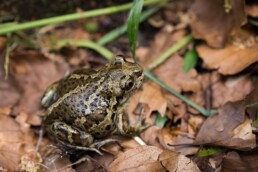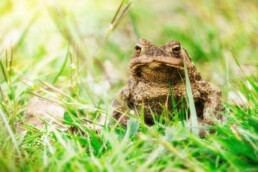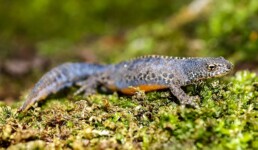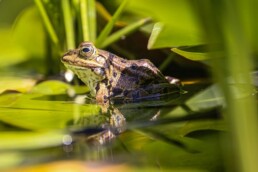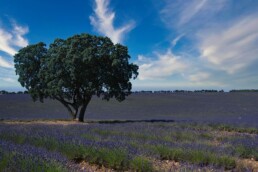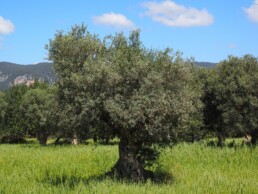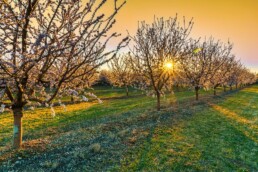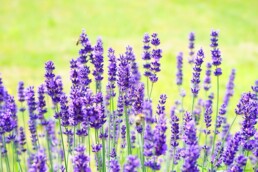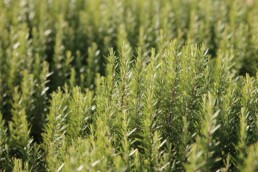Pelophylax perezi
Common frog
Scientific name
The common frog is known scientifically as Pelophylax perezi
Family
It belongs to the family Ranidae, which includes many species of frogs.
Distribution and Habitat
Common frogs are found in various parts of Europe, from northern Europe to mountainous regions in the south. They are also found in some areas of Asia. They inhabit a variety of aquatic habitats, such as ponds, lakes, streams and wetlands. They are usually found near water bodies during the breeding season and in wooded terrestrial areas during the rest of the year.
Behaviour
Common frogs are amphibians and have a dual life on land and in water. They are known for their distinctive song during the mating season, which is often a loud, repetitive sound. During winter, they may hibernate in shelters underground or at the bottom of bodies of water.
Feeding Habits
Common frogs are carnivorous and feed on a varied diet that includes insects, worms, spiders and other invertebrates. They are active predators and hunt prey with their sticky tongue.
Reproduction
Common frog reproduction involves the laying of eggs in bodies of water. Females lay eggs in gelatinous clusters that adhere to aquatic vegetation. After hatching, the aquatic larvae develop into tadpoles and undergo metamorphosis into adult frogs. During the mating season, males emit calls to attract females.
Common frogs play an important role in aquatic ecosystems and help control insect populations. They are known for their distinctive song and are a symbol of the arrival of spring in many regions.
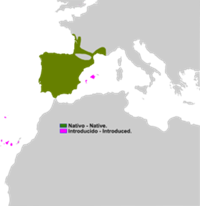
Epidalea calamita
Running Toad
Scientific name
The common toad is scientifically known as Epidalea calamita.
Family
It belongs to the family Bufonidae, which includes several species of toads.
Distribution and Habitat
The common toad is found in various parts of Europe, from north-western Europe to regions of southern Europe. They inhabit a variety of habitats, such as wet meadows, wooded areas and coastal areas. They are often associated with areas with seasonal water, such as temporary ponds and small water bodies.
Behaviour
Runner toads are nocturnal amphibians and tend to be active at night. During the day, they tend to hide in cool, damp shelters, such as under logs or rocks. They are known for their rough skin and variable colouring, which can range from green to brown.
Feeding Habits
Runner toads are carnivorous and feed on a variety of prey, including insects, spiders, worms and other invertebrates. They capture prey with their sticky tongue.
Reproduction
The reproduction of the racer toad involves the laying of eggs in bodies of water, such as temporary ponds. Females lay eggs that form a gelatinous chain in the water. After hatching, the aquatic larvae develop into tadpoles and undergo metamorphosis to become adult toads. During the mating season, males emit calls to attract females.
These toads are an important part of aquatic ecosystems and help in the control of insect populations. Conservation of their aquatic habitats is essential for their survival.
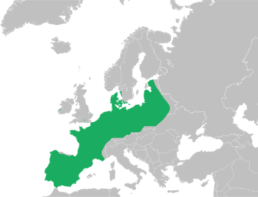
Lissotriton boscai
Iberian newt
Scientific name
The Iberian newt is scientifically known as Lissotriton boscai.
Distribution and Habitat
It is found in the Iberian Peninsula, including Spain and Portugal. It inhabits a variety of aquatic habitats, such as ponds, pools, streams and rivers. They are especially common in mountainous areas.
Behaviour
Iberian newts are aquatic amphibians and spend much of their lives in water. They are known for their bright colouring and their ability to regenerate limbs if injured.
Feeding Habits
They are carnivorous and feed on aquatic invertebrates, such as insects and mosquito larvae.
Reproduction
Reproduction of Iberian newts involves laying eggs in bodies of water. Females lay their eggs in aquatic plants. After hatching, the aquatic larvae develop and undergo metamorphosis to become adult newts.
These amphibians are important in the aquatic and terrestrial ecosystems they inhabit and play a crucial role in controlling insect populations.
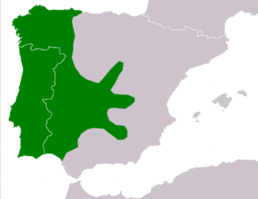
Discoglossus galgonoi
Iberian red-breasted ibis toad
Scientific name
The Iberian Spadefoot Toad is scientifically known as Discoglossus galganoi.
Distribution and Habitat
This species is found on the Iberian Peninsula, especially in mountainous and wooded areas. It inhabits aquatic habitats such as ponds, pools and freshwater streams. They are usually found near areas with dense vegetation.
Behaviour
Iberian paint-billed toads are amphibians that are usually active at night. During the day, they hide under rocks or in cool, damp places. They are known for their smooth, shiny skin.
Feeding Habits
They are carnivorous and feed on insects and other aquatic invertebrates.
Reproduction
Breeding involves the laying of eggs in bodies of water. Females lay their eggs in gelatinous masses that adhere to aquatic vegetation. After hatching, the aquatic larvae develop and undergo metamorphosis to become adult toads.
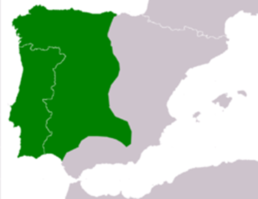
Quercus ilex
Holm oak
Scientific name
The holm oak is scientifically known as Quercus ilex.
Family
It belongs to the family Fagaceae, which includes other tree species such as oaks.
Description
The holm oak is an evergreen tree that can grow to heights of 20 to 25 metres. Its leaves are leathery, oval and dark green on the upper part, with a lighter shade on the lower part. The trunk is robust and has a thick, rough bark. Its fruits, called acorns, are small nuts contained in a dome.
Distribution
The holm oak is found in various regions of Europe, North Africa and Southwest Asia. It is particularly common in the Iberian Peninsula and southern France. It is widely adapted to different soil types and climatic conditions.
Use
The holm oak has historically been important for humans. Its acorns have been used as feed for pigs in some regions and have also been processed into acorn meal. Holm oak wood is valued for its hardness and durability, and is used in the manufacture of furniture, barrels, flooring and other wood products. In addition, holm oak plays an important ecological role in forests and is essential for the conservation of biodiversity in its habitat.
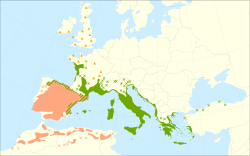
Olea europaea
Olive tree
Scientific name
The olive tree is scientifically known as Olea europaea.
Family
It belongs to the family Oleaceae.
Description
The olive tree is an evergreen tree that is widely known for its fruit, the olive. Its leaves are opposite, lanceolate and greyish-green on top, with a silvery tinge underneath. The trunk is twisted and often rough. The flowers of the olive tree are small and white or yellowish in colour. The fruits, olives, vary in size, shape and taste depending on the variety.
Distribution
The olive tree is native to the Mediterranean region and is found in countries in Europe, West Asia and North Africa. It has been introduced to other parts of the world where it is grown in suitable climates.
Use
The olive tree is one of the most cultivated fruit trees in the world due to the importance of its fruits. Olives are used for the production of olive oil, which is a fundamental component in Mediterranean cuisine and in many other cuisines around the world. In addition, olives are also consumed as snacks and used in various culinary preparations. Olive wood is valued in the manufacture of furniture and handicrafts because of its attractive grain and durability.
Olive cultivation is also an important part of agriculture in many Mediterranean regions, and olive oil is a significant export product. In addition to its culinary use, the olive tree also has cultural and historical importance in the Mediterranean region and is associated with peace and wisdom.
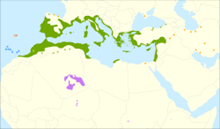
Prunus dulcis
Almond tree
Scientific name
The almond tree is scientifically known as Prunus dulcis.
Location
The almond tree is native to Southwest Asia, but is cultivated in many regions of the world with Mediterranean and temperate climates, including countries such as Spain, Italy, California in the United States and Australia.
Family
It belongs to the family Rosaceae.
Description
The almond tree is a deciduous tree that can reach heights of 4 to 10 metres. Its leaves are lanceolate and serrated at the edges, bright green in colour. The flowers of the almond tree are white or pinkish in colour and appear in spring before the leaves appear. The fruits of the almond tree are the almonds, which are contained within a hard shell.
Distribution
The almond tree is cultivated in many regions of the world, but is native to western and central Asia. It has adapted to Mediterranean and temperate climates and is grown in areas with mild winters and dry summers.
Use
The main use of almond trees is the production of almonds, which are a widely consumed nut used in cooking throughout the world. Almonds can be eaten raw, roasted or used to make a variety of products, from almond oil to sweets and cakes. Almond oil is also used in the cosmetics and personal care industry. In addition, almond wood has historically been used to make handcrafted objects and furniture because of its beauty and durability.
Lavandula angustifolia
Lavender
Scientific name
Lavender is scientifically known as Lavandula.
Location
Lavender is native to the Mediterranean region, but is grown in many parts of the world with temperate, dry climates. It is especially common in regions such as southern Europe, North Africa, southwest Asia and parts of North America.
Family
It belongs to the family Lamiaceae, which also includes other aromatic herbs such as mint and rosemary.
Description
Lavender is a herbaceous perennial plant that grows in compact bushes. Its leaves are linear, narrow and greyish-green. Its flowers are small and tubular, usually violet or blue in colour, although there are varieties with pink or white flowers. Lavender is known for its characteristic and pleasant scent.
Distribution
Lavender is cultivated in many parts of the world, but is native to the Mediterranean region, where it is found growing wild on hills and sunny slopes.
Use
Lavender is mainly used for its essential oil, which is extracted from the flowers. Lavender essential oil is used in perfumery, aromatherapy and personal care products because of its relaxing fragrance. It is also used in the manufacture of cleaning products and detergents due to its deodorising and antibacterial properties. In addition, lavender is grown in ornamental gardens because of its beauty and aroma. Its flowers can also be dried and used in aromatic sachets.
Lavender is known for its calming properties and is used in herbal teas and oils to promote relaxation and reduce stress.
Rosmarinus officianalis
Rosemary
Scientific name
Rosemary is scientifically known as Rosmarinus officinalis.
Location
Rosemary is native to the Mediterranean region, but is cultivated in many parts of the world with hot, dry climates. It is found in regions such as southern Europe, North Africa, southwest Asia and parts of North and South America.
Family
It belongs to the family Lamiaceae, which also includes other aromatic herbs such as mint, basil and sage.
Description
Rosemary is a perennial shrub that can grow to heights of 1 to 2 metres. Its leaves are small, linear, dark green on top and silvery underneath, giving it a distinctive appearance. The flowers are small, pale blue or white and have a distinctive scent.
Distribution
Rosemary is native to the Mediterranean region and is found in the wild in sunny, mountainous areas.
Use
Rosemary is widely used in cooking as an aromatic herb. Its leaves have an intense flavour and aroma and are used to season meat, poultry, fish and vegetable dishes. It is also used in the manufacture of rosemary essential oil, which has applications in aromatherapy and skin care due to its stimulating and antiseptic properties. In addition, rosemary is known for its traditional use as a medicinal plant to treat a variety of ailments, although it should be used with caution due to its potency.
Rosemary is also grown in ornamental gardens because of its beauty and fragrance, and its flowers attract pollinators such as bees.
Land investment is not a passing fad

In recent years we have witnessed a massive influx of capital into the world of agriculture worldwide.
Buying land, or leasing it on a long-term basis, is only the first step in what we might better call investment in agribusiness rather than in agriculture. If we look only at this first step of investment, the first thing that may come to mind is an idea of inflation in the value of the land itself and in the value of long-term rents, the latter aggravated in the Iberian territory by the "crazy" (I don't know if even headless) proliferation of fields for the production of solar energy.
The increase in land values is undoubtedly more than appreciable, and land values have, in many cases, doubled in the last five years. If we add to this increase in prices factors such as the war in Ukraine, the increase in inputs, the difficulties in obtaining water guarantees to ensure production, and even the decrease in population growth of the main food importer, China, the increase in transport and processing costs in the face of the endless new media in the food sector, we might wonder why there is such an influx of money into the world of agribusiness?
In contrast to the factors outlined in the previous paragraph, there are many compelling reasons for the growth of the agribusiness sector as a new investment market from a financial point of view.
Land inflation cannot be considered, as other authors claim, as the beginning of a new financial bubble similar to the one experienced in the construction sector. As we have said, the purchase of land is only the first step in a process of agribusiness investment, and much greater efforts are needed to develop and bring the land to yield. Yields that will last for many years and in most cases outlast the duration of the financial vehicles created to invest in the sector. This last fact will be one of the first things the market will have to learn in order to accommodate its rigid and stultified investment structures to a productive sector unlike any other investment niche so far explored by the financial industry.
The second step in making investments in agribusiness profitable and now that the value increases, although growing, is a scarce and "book" value, is the fact of transformation. The financial industry may be flocking to invest in agribusiness, each with a different intention, which we will explain later; but the capacity for transformation, the knowledge to generate an optimal and lasting financial result, resides in the hands of very few actors.
The financial industry is watching its money flow into a sector that is fundamentally family-based, with knowledge and ownership passed down from generation to generation, but where the professionalisation and "industrialisation" of farm management resides in a very small handful of companies. It is surprising that the financial sector is not looking at this and that these companies are not their primary target when considering investments in agribusiness.
The ultimate goal of agriculture is to create food to feed a growing world population. It is not for nothing that the FAO determines the usefulness of production and land used for agriculture in terms of the cost needed to generate 100 g of a given foodstuff. This alone would be enough to justify any investment in agribusiness.
Previously we commented that the financial industry is approaching agriculture for different reasons, some of which are simply internal; for example, the compensation of their investment portfolios in the face of the new sustainable investment rules, and which once again have caught the financial world "looking the other way".
Here again we find a factor intrinsically linked to the world of agriculture. Contrary to the widespread idea that agriculture is a polluting and "wasteful" factor of natural factors such as water, agriculture, the management of land over long periods of time, is the main investment asset that by its very nature is a source of environmental advantages. Its very functioning makes obvious the generation of circular economies, efficient water management (no sector has researched and introduced improvements in water management like agriculture), carbon sequestration... Agriculture, in short, has an impact, without any special effort, on 13 of the 17 SDGs.
Once again, in order to manage the concept of sustainability, the industry encounters the problem that there are very few actors who have the knowledge to implement these sustainability measures in their investments. Measures that also have a direct impact on reducing input costs and generating new revenue streams for their farms.
Without a doubt, sustainability is the common sense of agriculture.
In summary, we could say that land investment is not a fad, but only the first act of an investment industry that will have to evolve rapidly, because, once again, the underlying is more knowledge and expectations than the investment itself. It is our hope and expectation that the financial industry will focus on investments in agricultural technologies and agricultural operational capacity.
Investment in agribusiness, like sustainability, cannot have a partial vision, but must have a holistic vision.
Dimas Antúnez.

